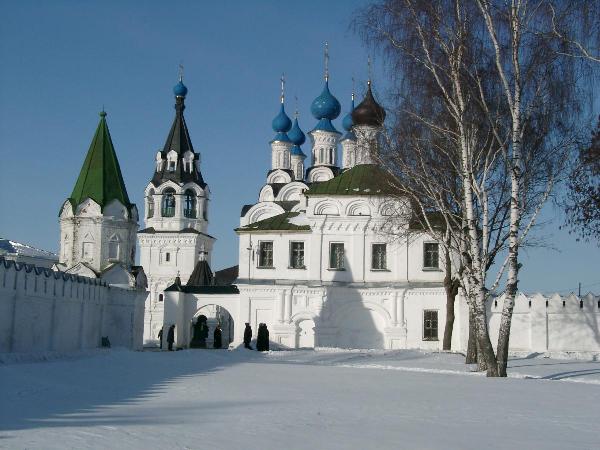

Location: Krasnoarmeyskaya ulitsa, 16
Found: mid- 16th century
Annunciation Monastery was found in the mid- 16th century by orders of Moscow tsar Ivan the Terrible on a site of the original Annunciation Church which contained relics of holy princes of Murom Konstantine, Michael, Fyodor and his sons. According to local legends during Christianization of the region Murom tribes refused to accept new religion. Prince Constantine was send to the region to spread Christianity. Murom in retaliation killed his son Michael and attacked palace of the prince. Constantine didn't have a significant army except a personal guard so he took the image of Our Lady of Murom and encountered armed men. Historic record state that Murom tribes were impressed by courage of Prince and found his words quiet convincing, so many took baptism immediately thereafter from a bishop of Murom Basil Muromsky. In 1547 Russian church council canonized royal rulers. After successful military campaign of Ivan the Terrible against Tatars of Kazan Russian tsar ordered construction of a new monastery.
Old Annunciation church was dismantled and in its place new stone Cathedral of the Annunciation was built.
It arose on the site of the wooden Church of the Annunciation of the
Most Holy Theotokos, the construction of which is attributed by
church tradition to the holy noble prince Konstantin (Yaroslav)
Svyatoslavich - the youngest son of the Chernigov prince Svyatoslav
Yaroslavich, the grandson of the great Kiev prince Yaroslav the Wise
(according to some sources, he could be the grandson of Yaroslav
Svyatoslavich of Ryazan.
The church legend tells the
following story. For a long time, the locals professed a pagan
religion and deified the forces of nature. Upon learning of this,
Prince Konstantin asked his father Murom for his inheritance in
order to convert the inhabitants of the city to the Christian faith.
In this charitable work, his sons Mikhail and Fedor helped him.
Murom pagans did not want to accept the prince, resisted and even
killed his youngest son Michael. However, then, shocked by a
miraculous sign from the icon of the Mother of God brought from
Byzantium, later called Murom, they repented of their crime and were
baptized in the waters of the nearby lake Kstovo.
It is known
that the holy Bishop Basil prayed in this temple.
In 1547, on
the basis of local veneration, a church-wide glorification of the
Right-Believing Prince Konstantin and his children Michael and
Theodore was performed.
The monastery was founded in 1553 by
Ivan the Terrible, who visited Mur in 1552 during a campaign against
Kazan.
Since 1555, the relics of Prince Konstantin openly
rested in the Cathedral of the Annunciation.
In 1616 the
monastery was destroyed and plundered by the Poles. During the 17th
century, the monastery was gradually reborn from the ruins.
Murom merchant Tarasy Tsvetnov rebuilt the Annunciation Cathedral in
1664 and installed a clock on the bell tower. In 1791, the Murom
Theological School was opened on the territory of the monastery. In
1792, the monastery survived a fire, but the stone buildings and the
main shrines survived. In connection with the fire, the Murom
Theological School was transferred to the caretaker's house, and in
1800 it was closed.
During the Patriotic War of 1812, the
Iverskaya and Vladimirskaya icons of the Mother of God were kept in
the monastery.
In 1866, the monastery received the second
class. In 1867-1882 it was ruled by the bishops of Murom, vicars of
the diocese of Vladimir.
The monastery was closed in 1919,
but the brethren, having settled in the city, continued to serve in
the cathedral.
On May 22, 1923, the relics of the holy noble
princes Constantine, Michael and Theodore were opened, after which
they were transferred to the museum, where they remained until
January 1989.
In 1940 the cathedral was closed, but it was
reopened two years later as a parish church.
Hieromonk Pimen
(Izvekov), later Patriarch of Moscow and All Rus', served here in
1946.
1800-1820 - Theophilus, abbot
1821-1825 - Nikodim (Bystritsky),
abbot
1825-1830 - Jerome (Agrikov), abbot
1831-1833 -
Procopius (Razumovsky), abbot
1833-1843 - Varlaam (Vigilyansky),
hegumen
1843-1845 - Nifont (Uspensky), abbot
1845-1856 -
Innokenty (Florinsky), abbot
1857-1858 - Gideon, abbot
1858-1860 - Marcellin, archimandrite
1858-1860 - Alexy
(Novoselov), archimandrite
1868-1868 - Andrei (Pospelov), Bishop
of Murom
1870-1882 - Jacob (Krotkov), Bishop of Murom
1882-1894 - Alexy (Polisadov), archimandrite
1894-1897 - Misail
(Smirnov), archimandrite
1899-1912 - Alexander (Mirtov),
archimandrite
1913-1913 - Nikon (Troitsky), archimandrite
1913-1915 - Nikolai (Stroev), hegumen (and in 1918)
1915-1930 -
Melchizedek (Birev), archimandrite
1991-1993 - Sylvester
(Smerdov), hegumen
1994— — Kronid (Kozlov), archimandrite
In September 1991, by the decision of the Holy Synod, monastic life
was resumed in the Annunciation Monastery.
In the crypt of
the cathedral lie the relics of St. Basil of Murom - "Enlightener of
the Murom peoples" and St. Julian (Kochukov) - an ascetic of the
17th century.
In the necropolis of the monastery, prominent
residents of Murom and clergymen are buried, among them is the abbot
of the monastery, Archimandrite Alexy (Polisadov), the
great-grandfather of the poet Andrei Voznesensky.
The main church of the monastery is the Annunciation Cathedral (construction began in the 16th century, rebuilt in the 1660s). The exterior decoration of the cathedral is one of the textbook examples of patterning. The Annunciation Cathedral was the only building that survived the destruction of the monastery during the Time of Troubles. A hipped bell tower is attached to the cathedral. The gate Stefanievskaya church traditionally dates back to 1716. In 1811, a monastery fence with turrets was built.
The ashes of many prominent citizens are buried in the necropolis of
the monastery.
The Annunciation Monastery was sung by Andrei
Voznesensky in the poem "Andrey Polisadov" - about the poet's
ancestor, the rector of the monastery, Archimandrite Alexy
(Polisadov), who was buried behind the altar of the cathedral.